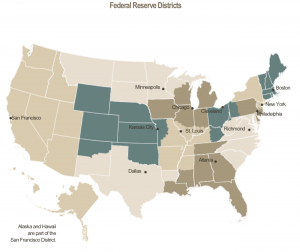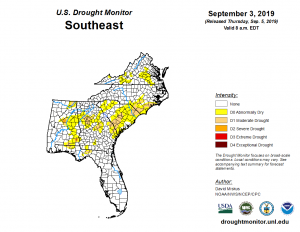Federal Reserve: Observations on the Ag Economy- August 2019
Last week, the Federal Reserve Board released its August 2019 Beige Book update, a summary of commentary on current economic conditions by Federal Reserve District. The report included several observations pertaining to the U.S. agricultural economy.
* Fifth District- Richmond– “In general, trade issues and low commodity prices were hurting farmers, including by lessening their ability to repay loans and by reducing their desire to purchase new equipment.”
* Sixth District- Atlanta– “Agricultural conditions across the District were mixed. Recent reports indicated much of the District was drought-free although parts of Alabama, Georgia, the Florida panhandle, and Tennessee experienced abnormally dry to moderate drought conditions.
“Some producers in Louisiana reported crop damage due to Hurricane Barry. Average farm real estate values in the District rose year-over-year with the exception of Georgia, where values declined. On a year-over-year basis, prices paid to farmers in June were up for corn and beef but down for cotton, rice, soybeans, broilers, and eggs.”
* Seventh District- Chicago– “Farm income prospects improved some, but remained poor for most agriculture sectors.
“Expectations for corn and soybean output improved some but were still much lower compared to a year ago, and the condition of crops was highly variable. Crop development was as much as a month behind normal because the wet spring delayed planting. Prices for corn and soybeans declined.”
“Egg and dairy prices moved higher, while hog and cattle prices moved lower. Contacts noted that another round of payments from the Market Facilitation Program, along with other government programs, were helping to make up for low farm incomes.”

USDA- Economic Research Service Webinar, “Farm Income and Financial Forecasts, August 2019” (August 30, 2019).
* Eighth District- St. Louis– “District agriculture conditions were down modestly from the previous reporting period. Compared with mid-July, the percentages of cotton and rice rated fair or better declined modestly, while those for corn and soybeans declined slightly. Relative to the previous year, the percentage of all four crops rated fair or better declined moderately. District contacts indicated that farming conditions remained strained due to low commodity prices and lingering effects from the unusually wet weather and flooding in the spring. New government assistance to farmers is expected to provide some short-term alleviation.”
* Ninth District- Minneapolis– “District agricultural conditions remained weak. Recent estimates lowered the planted acreage and expected production for corn, soybean, and spring wheat in District states compared with last year, due in part to heavy rains and flooding. Respondents to the Minneapolis Fed’s second-quarter (July) survey of agricultural credit conditions indicated that farm income and capital spending decreased relative to a year earlier, with further declines expected for the coming three months. However, some contacts expressed optimism about a recent rally in commodity prices.”
* Tenth District- Kansas City– “The Tenth District farm economy remained weak, and commodity prices declined in response to supply expectations and trade uncertainty.
“Regional contacts reported weak farm income in the most recent survey period, but expected slower deterioration in the coming months.”
“Less pessimistic expectations in the second quarter were supported by increases in crop prices earlier in the year. However, sharp declines in crop and livestock prices in August weighed on farm revenues. Hog and soybean prices declined moderately alongside ongoing trade disputes, and cattle prices decreased sharply following a substantial disruption at a major beef processing facility located in the District. Corn and wheat prices also declined sharply following higher-than-anticipated production estimates.”
* Eleventh District- Dallas– “Higher temperatures and a lack of rainfall negatively impacted the agriculture sector over the past six weeks, with drought conditions creeping back in to parts of the district. Dryland grain crops were largely well established before weather conditions deteriorated, so solid yields were expected. Irrigated crops planted later in the growing season were feeling more of the negative impact of the weather.
“Most agricultural commodity prices moved down over the reporting period, prompting some pessimism among agricultural producers.”
* Twelfth District- San Francisco– “Demand for agricultural products generally softened, both externally and domestically with notable exceptions in nuts and grapes markets.
“Trade tensions, a strong dollar, and a less optimistic economic outlook were identified as the main factors behind slower overall demand.”
“Producers of beef, poultry, and pork products sought alternative markets after further escalation of trade tensions with China. Fruit and wheat farmers in the Pacific Northwest noted a decline in their export business…A contact in Central California observed stable prices but lower demand for farmland.”
Source: Keith Good, Farm Policy News



